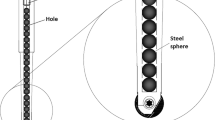Abstract
In internal turning operation of long holes, the tool is not rigid, since it must be out from the lathe turret in a length longer than the machined hole length. This problem is even more serious in the internal turning of hardened steels, where the requirements for surface quality are more restrict, due to the fact that this is a finishing operation, which aims to replace grinding. Therefore, some procedures have to be taken in order to minimize vibration and, consequently, to make the attainment of a good workpiece surface quality possible. One of these procedures is the use of a damped tool. In this work, we tried a simple and different kind of impact damped tool bar, using spheres placed in a cavity manufactured in the tool bar. The performance of this impact damper with three different sizes of spheres was compared to the performance of a solid steel bar, in terms of workpiece surface roughness, tool vibration, and tool life. The main conclusion of this work is that the use of the kind of impact damper tested in this work makes possible the increase of the tool overhang (tool length outside the machine turret) without damaging surface roughness and tool life and, consequently, it also makes possible the turning of longer holes than when a solid bar is used.
Similar content being viewed by others
References
Badadhe AM, Bhave SY, Navale LG (2005) Optimization of cutting parameters in boring operation. J of Mech and Civ Eng:10–15
Bonifácio MER, Diniz AE (1994) Correlating tool wear, tool life, surface roughness and tool vibration in finish turning with coated carbide tools. Wear 173:137–144
Albuquerque MV (2016) Modelagem e Análise Dinâmica de um Absorvedor de Vibrações por Efeito de Impacto (Dynamic modeling and analysis of a vibration damper by impact effect). Master’s Thesis, State University of Campinas, Campinas Brazil
Suyama DI, Diniz AE, Pederiva R (2016) The use of carbide and particle-damped bars to increase tool overhang in the internal turning of hardened steel. Int J Advan Manuf Tech 86:2083–2092. https://doi.org/10.1007/s00170-015-8328-z
Schneider G (2010) Cutting tool applications chapter 10: boring operations and machines - American Machinist. Modern Machine Shop, http://www.americanmachinist.com/; 2010 [accessed: 12 February 2017]
Smith GT (2008) Cutting tool technology: industrial handbook. Springer-Verlag, Southampton (UK)
General Carbide (2014) Designer guide, http://www.generalcarbide.com/PDF/Designer-Guide.pdf; 2017 [accessed: 12 February 2017]
Andrlen L, Håkansson L, Brandt A, Claesson I (2004) Identification of dynamic properties of boring bar vibrations in a continuous boring operation. Mech Syst Signal Process 18:869–901
Hwang HY, Kim JK, Lee DG (2003) Design and manufacture of a carbon fiber epoxy rotating boring bar. Compos Struct 60:115–124
Kanase SS, Patil JS, Jadhav SM (2013) Improvement of Ra value of boring operation using passive damper. Int J Eng Sci 2:103–108
Biju CV, Shunmugam MS (2014) Investigation into effect of particle impact damping (PID) on surface topography in boring operation. Int J Adv Manuf Technol 75:1219–1231
Booty C, Bowyer EP, Krylov VV (2014) Experimental investigation of damping flexural vibrations using granular materials. International Congress on Sound and Vibration Department of Aeronautical and Automotive Engineering. Loughborough University, Loughborough, Leicestershire, England
Sims ND (2006) Vibration absorbers for chatter suppression: a new analytical tuning methodology. J Sound Vib:1–16
Khatake P, Nitnaware PT (2013) Vibration mitigation using passive damper in machining. Int J Modern Eng Res 3:3649–3652
Paul PS, Varadarajan AS (2014) Effect of impact mass on tool vibration and cutting performance during turning of hardened AISI4340 steel. Romanian J of Acoust and Vibrat 11:154
Lu Z, Wang Z, Masri SF, Lu X (2018) Particle impact dampers: past, present, and future. Struct Control Health Monit 25(1):2058
Popplewell N, Semercigil SE (1989) Performance of the bean bag impact damper for a sinusoidal external force. J Sound Vib 133(2):193–122
Xiao W, Jin L, Chen B (2015) Theoretical analysis and experimental verification of particle damper-based energy dissipation with applications to reduce structural vibration. Shock Vib 2015:1–8
Lu Z, Wang DC, Masri SF, Lu XL (2016) An experimental study of vibration control of wind-excited high-rise buildings using particle tuned mass dampers. Smart Struct Syst 18:93–115
Halliday D, Robert R, Merrill J (1981) Fundamentals of physics, vol 9. Wiley, New York
Cheng J, Xu H (2006) Inner mass impact damper for attenuating structure vibration. Int J Solids Struct 43:5355–5369
Yao Z, Mei D, Chen Z (2009) On-line chatter detection and identification based on wavelet and support vector machine. J of Mat Proc Tech 713 - 719
Silva WTA (2017) Uma contribuição ao uso de barras de tornear com amortecimento de impacto por esferas (A contribution to the use of impact damped turning tool bar with spheres). Master’s Thesis, State University of Campinas, Campinas Brazil
Diniz AE, Coppini NL, Marcondes FC (2014) Tecnologia da usinagem dos materiais (Technology of machining of materials), 9° edn. Art Liber Editor, São Paulo Brazil
Waydande P, Ambhore N, Chinchanikar S (2016) A review on tool wear monitoring system. J of Mech Eng Aut 6:49–53
Agostinho OL, dos Rodrigues ACS, Lirani J (1977) Tolerâncias, ajustes, desvios e análise de dimensões (Tolerances, adjustments, deviations and dimension analysis). Ed. Blücher, São Paulo (SP) Brazil
Author information
Authors and Affiliations
Corresponding author
Rights and permissions
About this article
Cite this article
Diniz, A.E., da Silva, W.T.A., Suyama, D.I. et al. Evaluating the use of a new type of impact damper for internal turning tool bar in deep holes. Int J Adv Manuf Technol 101, 1375–1390 (2019). https://doi.org/10.1007/s00170-018-3039-x
Received:
Accepted:
Published:
Issue Date:
DOI: https://doi.org/10.1007/s00170-018-3039-x




